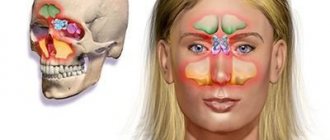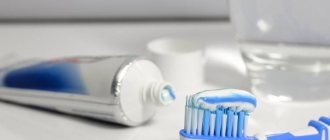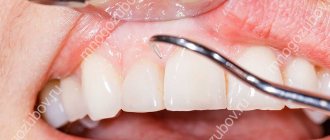Types of pathology
There are several types of maxillary sinus cysts:
- Odontogenic. The inflammatory process forms in the root system of an untreated dental unit located on the upper jaw. As the tumor increases in size, it destroys the bone and grows into the sinuses. The contents of the cyst are purulent.
- Retention. The reason for the development is dysfunction and obstruction of the glands responsible for the production of mucus.
False cysts are classified into a separate category. In such formations there are no epithelial cells. The appearance of such formations is due to a violation of the structure of the maxillofacial apparatus.
Surgical removal of a cyst in the maxillary sinuses
Other types of cysts and large root cysts that are not suitable for conservative treatment are removed during surgery. Before the procedure, a computed tomography scan is performed, which allows you to accurately determine the location of the lesion and plan the procedure so that it takes place in the least invasive way.
The patient is also prescribed blood tests: morphology with platelets, coagulation, blood group and other additional tests as prescribed by the doctor. If the patient suffers from chronic diseases, consultations are held with relevant specialists (cardiologist, endocrinologist, neurologist). Before the operation, an anesthetic consultation is carried out to determine the dosage and type of general anesthesia.
The operation to remove a cyst in the maxillary sinus is performed using endoscopic or classical methods: this largely depends on the location and size of the cyst being removed. Due to the small post-operative wound, low invasiveness of the procedure and short recovery period, endoscopic sinus treatment is more often used. In case of concomitant infection of the secretion filling the cyst, antibiotic therapy is also indicated.
Description of the procedure
When removing a cyst of the right or left maxillary sinus, the surgeon’s task is to remove the affected mucous membrane of the sinus and other pathologies in its lumen and create a new opening connecting the sinus to the nasal cavity. Several types of surgery are used to remove a cyst:
- cystectomy – excision and curettage of the entire cyst cavity, followed by suturing;
- cystotomy - excision of the anterior wall of the tumor and communication of the posterior wall with the oral cavity.
The procedure is performed under general anesthesia and only in exceptional cases can local anesthesia be used.
Tissue and fluid from the cyst cavity collected during surgery are sent to the laboratory for histopathological examination, which allows us to determine the type of benign tumor and exclude the presence of malignant tumors.
Causes
The key reason for the formation of a maxillary sinus cyst is dental disease. Especially when treatment was not carried out or performed poorly. Pathology develops against the background of advanced caries, periodontitis and pulpitis on chewing units. This is due to anatomical features. Premolars and molars are located closest to the paranasal sinuses and are separated from them by a thin septum.
Until recently, teeth with cysts were subjected to extraction. Today, dentists prefer to perform organ-preserving surgeries. All stages of work are performed under control using a dental microscope.
An endodontist removes the cyst, performs sterilization and filling of the canals.
The formation of a tumor can be caused by a deviated nasal septum, jaw abnormalities, or chronic blockage of the ducts of the nasal glands due to rhinitis or sinusitis.
Diagnosis of the disease
A neoplasm measuring up to 15 mm is diagnosed only with a CT scan. A dentist can suspect the presence of a pathology during a routine examination of the patient’s oral cavity based on existing complaints.
Clinical symptoms
As the cyst grows, the patient develops alarming symptoms similar to those of acute sinusitis. These include:
- acute headache;
- chronic nasal congestion;
- clear or yellow nasal discharge;
- a feeling of heaviness and fullness in the area under the eyes;
- the presence of a viscous mucous lump in the throat after waking up.
Clinical symptoms become more pronounced as the lumen in the nasal cavity closes. If there are concomitant dental problems, pain in the tooth and swelling of the gums occur.
Potential Complications
If left untreated, the infection spreads to adjacent teeth in the upper jaw. There is a risk of bone deformation or jaw fracture, the development of an abscess, phlegmon and other purulent complications.
The cyst is accompanied by sinusitis and chronic sinusitis. The growth of the tumor is dangerous due to visual impairment. The formation of a purulent cyst can lead to the development of meningitis or encephalitis.
Complex treatment
When treating pathology, dentists use medicinal and surgical techniques. The tumor is removed during surgery. Further drug therapy is designed to eliminate the symptoms of the inflammatory process and prevent complications.
Treatment in dentistry
Most patients go to the dentist when the size of the cyst exceeds 1 cm. The dental surgeon removes the bag of pus by cystectomy or cystotomy. The choice of technique is based on the size of the cyst and clinical indications.
The dentist is faced with a number of tasks:
- remove the source of inflammation in the oral cavity and stop the inflammatory process;
- provide drainage for the outflow of pus;
- if possible, save the diseased tooth;
- fill the resulting cavity with bone material;
- close the fistula between the oral cavity and the sinus.
Inpatient treatment in the ENT department
If the appearance of a cyst is caused by ENT pathologies, you should consult an otolaryngologist. Tumors are removed by surgery, laser or gentle endoscopic techniques. During endoscopy, the doctor gains access to the affected area through the nasal passages or an opening in the facial wall of the maxillary sinus. Control of manipulations on the monitor screen is carried out.
Cysts, polyps of the paranasal sinuses. Odontogenic sinusitis: symptoms, causes, treatment
The formation of a cyst occurs due to impaired ventilation of the paranasal sinuses and the outflow of mucus, i.e. There is no physiological gas exchange and removal of mucous membrane secretions from the sinus. This leads to dysfunction of the secretory cells of the mucous membrane, which begins to grow, the gland duct is blocked and a cyst is formed in the form of a thin-walled bubble with liquid inside. The causes of the appearance of cysts are chronic inflammation of the nasal cavity, the polypous process, as well as inflammatory processes in the roots of the teeth located in close proximity to the sinuses.
Polyps of the maxillary sinus are growths of the nasal mucosa, which appear due to the presence of chronic inflammation with insufficient treatment of colds or allergic diseases, as well as in the presence of immunological changes.
Odontogenic sinusitis develops due to the penetration of infection into the maxillary sinus from an inflammatory focus in the roots of the teeth located in close proximity to the maxillary sinus. As medical practice shows, patients very often turn to an otorhinolaryngologist with symptoms of odontogenic sinusitis after dental surgery. In some patients, inflammation of the maxillary sinus was caused by an infection remaining in the tooth socket, in others, the infection penetrated into the sinus after surgical removal of the tooth, and still others complained of sinusitis due to the filling substance getting into the nasal appendages.
Symptoms of odontogenic sinusitis
Symptoms of odontogenic sinusitis, cysts and polyps
- frequent colds
- migraine-like headache
- temporary or permanent nasal congestion and difficulty breathing
- unpleasant odor from the nose and mouth
- accumulation of mucus and phlegm in the throat
- mucous, light or cloudy purulent discharge from the nose
- dysfunction of the sense of smell
Treatment
At the Federal State Budgetary Institution National Medical Research Center of Otorhinolaryngology, Federal Medical and Biological Agency of Russia, the treatment of sinusitis, cysts and polyps is carried out by specialists from the scientific and clinical department of diseases of the nose and pharynx under the guidance of a talented doctor, Ph.D. V.M. Averbukh. The Center's modern diagnostic equipment, extensive experience of doctors and the successful use of the latest developments and techniques in the field of treatment of sinusitis help not only to correctly diagnose the disease, but also to prescribe effective treatment.
The Center's specialists believe that not all types of cysts and polyps require surgical removal. As practice shows, in most cases, acute inflammation in the maxillary sinus responds well to conservative treatment - the right combination of anti-inflammatory, antibacterial and antiallergic drugs. Patients should be aware that the cyst does not resolve on its own and only in very rare cases is it evacuated from the sinus spontaneously. Only a specialist can determine the type and nature of the cyst and prescribe the correct solution to the problem. If the cyst is large and its volume puts pressure on the walls of the sinus, surgical intervention is indicated.
But before prescribing an individual course of treatment, it is necessary to conduct a thorough diagnostic examination of the patient.
Diagnostics
In the scientific and clinical department of diseases of the nose and pharynx, various modern types of diagnostics are used:
- radiography
- orthopantogram (panoramic X-ray of the jaw)
— CT scan of the paranasal sinuses
— Dental CT
— Videoendoscopy of the nasal sinuses
— MRI of the paranasal sinuses
The Center’s specialists have at their disposal various techniques developed not only by the best domestic and foreign clinics, but also their own. Endoscopic surgery on the maxillary sinus, which is performed both under local anesthesia and general anesthesia, is one of the most modern techniques used in the Center. This operation requires high skill and extensive experience of the surgeon. Through the natural anastomosis of the maxillary sinus, the surgeon carefully performs endoscopic removal of the cyst. The instrument is inserted through the patient's nose without incisions or punctures. The department’s surgeons believe that this technique has no contraindications for use, does not lead to complications, and does not require a long hospital stay. However, if it was not possible to completely remove the cyst using the mentioned method, the surgeon uses a trocar to make a 4mm hole under the upper lip in the vestibule of the oral cavity.
When a foreign body or cyst is located in the bottom of the sinus, the most modern surgical technique is used - minimally invasive removal of pathological formations using infraturbinal access (through the lower nasal passage), without forming a permanent connection between the sinus and the nasal cavity and preserving the mucous membrane. The choice of the most effective surgical intervention and the method of its implementation depend on the nature, localization of the pathological process and the experience of the surgeon.
For each patient of the Center, specialists develop an individual treatment program, and the attention and caring attitude of the staff is guaranteed to everyone!
If left untreated, vision and more can seriously deteriorate.
Cysts of the maxillary sinuses are dangerous because if they are not treated, they can become a source of very serious health problems.
The infection can spread to the nearby teeth of the upper jaw and along the chain take over the entire row, as a result of which you can lose all your teeth. Pathology can lead to deformation of the skull bones and jaw fracture, the development of purulent processes - abscess, phlegmon, osteomyelitis, meningitis.
The tumor provokes the development of sinusitis and chronic sinusitis. Its presence is always accompanied by a runny nose and inflammation of the sinuses.
If the problem is not addressed, it can affect vision
The growth of the tumor often leads to blurred vision, “double vision.” If the cyst is purulent, it can lead to brain damage and encephalitis. When a tumor grows, there is a risk that it will completely block oxygen and complicate breathing, which is especially dangerous during sleep, since a person may not wake up.
What kind of disease is this
In general, a cyst is a benign formation, similar to a cavity, with contents inside the walls.
In addition to the maxillary, it is often found in the sinuses near the nose, but under no circumstances does it extend beyond these zones. The cyst can be of any size - from small formations in the initial stages to large ones that expand if treatment is started.
There are two mechanisms for the development of education:
- Retention , which occurs and develops if the excretory duct of the glands in the mucous membrane is blocked.
- Odontogenic , progressing as a dental pathology, i.e. due to diseases of teeth and gums.
Both single and multiple cysts can also be detected. In some people this formation is acquired, while in others it is present from birth.
This is a very common disease: according to statistics, in every fifth person, a detailed examination of the nose can reveal a small maxillary sinus cyst (MSC). Such formation does not make itself felt for a long time, or manifests itself in the form of pain and unpleasant symptoms.
The patient who has been diagnosed with a cyst is being monitored dynamically. If his condition worsens sharply, surgical intervention is possible.
ENT about a cyst in the sinus:
ICD code
There are two disease codes according to the ICD:
- 8
- K09
Each of them is assigned depending on how the cyst was formed and what type it acquired.
Diagnosis of sinus cysts
In addition to the standard questioning and examination of the patient, all doctors at the Lor-Plus clinic are proficient in endoscopic examination techniques. Using an endoscope - a long thin tube with a miniature video camera, the doctor can conduct the most complete examination of the ENT organs, determine the presence of additional structural features of the nasal cavity, changes in the nasal mucosa in the deep sections that may interfere with normal breathing.
Currently, the gold standard for diagnosing sinus cysts is computed tomography . This method allows you to determine the size of the cyst and its location in the sinus with millimeter accuracy, which is very important for choosing a method for removing the cyst.
After removal of the cyst, you need to adhere to restrictions
Treatment of tumors in most cases involves their surgical removal. And naturally, after surgery the body needs time to recover. Usually 7–14 days. During this period, swelling, soreness, and difficulty breathing are normal. To make unpleasant symptoms go away faster, you must follow these tips:
- use antibiotics, antiseptics and vasoconstrictors prescribed by your doctor,
- avoid actions that provoke active use of facial muscles: long conversations, laughing, yawning, blowing your nose,
- do not visit saunas, steam rooms, do not take hot baths,
- follow a gentle diet with a predominance of soft and not too hot food,
- reduce the intensity of physical activity as much as possible; it is better to avoid visiting gyms altogether for a while,
- buy a high pillow: when sleeping, your head should be higher than your body level.
Sleeping on a high pillow promotes a speedy recovery after treatment.
Doctors consider the main measure to prevent maxillary sinus cysts to be timely treatment of dental problems and ENT diseases, sanitation of the oral and nasal cavity, as well as correction of jaw and nasal abnormalities (for example, the nasal septum), if they occur. be.
Notice
: Undefined variable: post_id in
/home/c/ch75405/public_html/wp-content/themes/UltraSmile/single-item.php
on line
45 Notice
: Undefined variable: full in
/home/c/ch75405/public_html/wp-content /themes/UltraSmile/single-item.php
on line
46
Rate this article:
( 5 ratings, average: 3.60 out of 5)
flux
- Sirak S.V. [and others] Surgical treatment of odontogenic cysts of the upper jaw penetrating into the maxillary sinus, based on clinical and morphological research data // Medical Bulletin of the North Caucasus. – 2014.
Expert “In advanced dental diseases, such as pulpitis and periodontitis, there may be several mechanisms for the development of a maxillary cyst. The first is that the formation appears at the root of the diseased tooth, and then grows into the sinuses. The second is that the infection spreads upward through the root canals, and a cyst begins to form in the sinus. In this case, it is possible to prevent the development of pathology if “dental problems” are solved in a timely manner. Dentist-therapist Elena Vladimirovna Orlova
Consulting specialist
Dzhutova Aida Vladimirovna
Doctor rating: 8.8 out of 10 (5) Specialization: Implant surgeon, periodontist Experience: 10 years
The maxillary cyst is most often located in the nose area
The maxillary sinus cyst consists of epithelial cells of the mucous membrane. Inside it can be filled with mucus, serous contents or pus. Most often it is localized in the area of the sinuses, that is, the paranasal sinuses, which is why the pathology is also called a maxillary sinus cyst.
A maxillary cyst is often called a maxillary sinus cyst.
Symptoms of a maxillary sinus cyst
So, what symptoms should you pay attention to? In what cases is it necessary to consult a doctor?
Of course, first of all, it should be said that a maxillary sinus cyst (both right and left) can develop asymptomatically (that is, its appearance and constant presence in the maxillary sinus does not cause discomfort for a person) with a diameter of less than 1 cm.
In this case, usually, the detection of a cyst occurs either accidentally (for example, an x-ray examination to confirm the diagnosis of sinusitis), or with further significant growth of the tumor (more than 1 cm in girth).
If a cyst in one of the sinuses causes discomfort (it is larger than 1 cm), then the following symptoms are observed:
- difficulty breathing (especially after exercise),
- constant nasal congestion (a common symptom for children),
- local pain over the affected sinus (usually the maxillary, right or left),
- false symptoms of increased intraocular pressure (caused by a cyst with a volume of more than 1 cm, hence the unpleasant sensations),
- purulent discharge (if concomitant diseases are headed by sinusitis),
- symptoms of innervation damage (hypo- or anosmia - loss of smell),
- excruciating headaches that quickly recover even after strong analgesics (compression of the trigeminal nerve branch).
All of these listed symptoms are a reason to contact an ENT doctor in order to avoid complications that such a process can cause!
Diagnosis of perforation of the maxillary sinus floor
Checking for perforation of the maxillary sinus floor involves a comprehensive analysis of the typical clinical picture. It is necessary to take into account the condition of the socket of the extracted tooth, the presence of air bubbles, and bleeding from the nasal cavity. An X-ray examination is done, which shows the area of the hole with high accuracy.
The dentist may prescribe a procedure to insert a probe into the perforated canal. This will determine the presence of a bone bottom in the wound. The probe should pass through soft tissues without hindrance, without stopping or clinging to foreign bodies.
X-ray analysis will allow you to see darkening, characteristic of the presence of an accumulation of blood clots. In addition, X-ray images clearly show filling materials, implants, and fragments of tooth roots. Often, radiography uses a bright substance to clearly see the condition of bone and other types of tissue. To do this, the substance is placed into the cavity through the fistula.
An instrumental diagnostic method – computed tomography – will help determine the degree of perforation and the presence of foreign bodies.
If perforation is suspected, general clinical tests are prescribed to help determine the existence of infection in the human body.
Main symptoms
This problem makes itself felt with a whole range of symptoms.
| Symptom | Description |
| Nasal congestion | The primary symptom that signals clogged ducts. A person experiences difficulty breathing through the nose and discomfort in the upper jaw. Rapid irritability and poor performance appear. There is a risk of exacerbation of chronic sinusitis or rhinitis. Manifests itself in everyday life or during physical activity. People, for example, who go diving, may experience problems. When diving under water, they will feel unpleasant pressure and pain in the area where the cyst has formed. If swelling appears or fluid begins to leak out, this leads to the appearance of ENT diseases. |
| Headaches, cheek and eye pain | Symptoms characteristic of both cysts in one and two sinuses. All this affects the overall performance of a person, appetite, drowsiness, as well as the respiratory process. In special cases, the patient suffers from vision problems (double vision). Sometimes a cyst located on one side can manifest itself with unilateral symptoms. For example, headaches and nasal congestion are felt mainly on the side where the tumor appeared. Pain and swelling in the cheeks can spread to healthy teeth. There is a risk of unpleasant sensations in the forehead area. Regular headaches and intoxication of the body occur. Clogged sinuses cause severe pain when tilting the head. |
| Mucus and pus in the throat | The patient notices a strong discharge of clear yellow liquid from the nose. It can leak from one or two nostrils, depending on the location of the cyst. This phenomenon appears as a result of film rupture and leakage of a cyst-like formation. This will not last long, but the risk of contracting an infection during this period increases significantly. |
| Temperature | A natural reaction of the body, signaling the fight against an infection in the sinus. Cyst-shaped tumors take a long time to form, so elevated temperatures can also persist for a long time. |
Cyst in the maxillary sinus and sinus lift
Many patients are interested in the question of whether it is possible to simultaneously extract a cystic formation and perform bone grafting of the upper jaw. The answer to this question depends on several factors, which include:
- The degree of severity of bone tissue atrophy at the site of the cyst (in some cases, the deficiency is so pronounced that sinus lifting becomes impossible, and patients can only hope for the installation of removable dentures);
- The presence of an active inflammatory process (cysts are often complicated by infectious pathologies, especially sinusitis, which are a direct contraindication for surgery);
- The size of the cystic formation (small cavities can be removed immediately before sinus lifting, but if the cyst occupies the entire space of the sinus, then bone grafting is out of the question);
- The location of the cyst (if it is located on the lower wall, then problems with removal during sinus lifting usually do not arise, but if the formation is located higher, the dentist simply will not be able to reach it without injuring the walls of the sinus).
Performing a sinus lift with preliminary removal of a cystic formation is performed quite rarely and only in cases where the process has just begun to develop and was accidentally discovered by instrumental studies. The doctor must correctly weigh the benefits and risks of future surgery. Most often, patients are transferred for treatment to ENT specialists, and the sinus lift is postponed to a later time.
One of the most common causes of tumor is a bad tooth.
A maxillary sinus cyst can form due to a reason such as dental disease. More precisely, when treatment was not carried out, or it was performed poorly. Most often, the development of pathology is provoked by advanced caries, pulpitis and periodontitis on molars and premolars (these teeth are separated from the paranasal sinuses by a thin septum).
Teeth with cysts and granulomas were previously more often removed than treated. Today, in some clinics, high-precision tooth-preserving operations are carried out, where all stages of treatment are accompanied by work on a dental microscope. A competent endodontist carefully removes the cyst under a microscope using special instruments, then the canals are sterilized to their entire length and filled with filling material. Treatment under a microscope is accurate, fast, without risks or complications, and, most importantly, the natural tooth remains intact.
The prerequisite for the appearance and growth of a tumor may be the individual anatomical characteristics of the patient, for example, a deviated nasal septum or jaw abnormalities. Another reason is the systematic blockage of the ducts of the glands located in the nose, against the background of rhinitis, runny nose, and allergic reactions.










